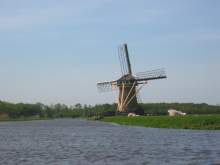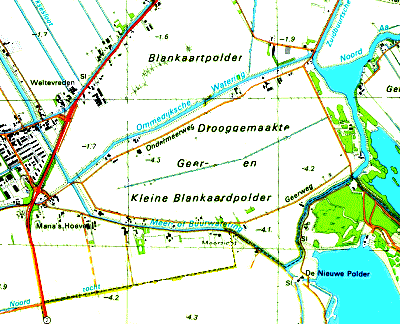
A typical Dutch windmill
The first inhabitants of the wet areas chose suitable places to stay, and started digging peat to be used as fuel when dried. This digging of peat continued until after the middle ages, and resulted in quite a few lakes that grew as the shores were washed away during storms.
While this was going on, people also started to change the land to suit their needs and to provide some security against the water. At first ditches were dug to drain the higher parts, but later small patches of wet land and marshes were enclosed with dikes and pumped dry. Canals around the outside of the dikes were used to move the water away. From the midddle ages the pumping was done mainly by windpower, and although many are now defunct or demolished there are still quite a few windmills present. Later, as the population increased there was more need for dry land, and as the industrial revolution progressed, larger marshes, former peat lakes and even parts of the inland sea "Zuiderzee" were converted to dry land by means of steampower and electric pumps. Some parts were more difficult to pump dry and still many lakes and wetlands remain.
Aside from this, there is also the extensive dike and dam system along the rivers and coast that protects us from flooding. This protection has not always worked, in 1421 large parts of the land were flooded, remnants of which still are visible in the "Biesbosch" (meaning "Reedwood"), a fairly large maze of tidal waterways and land (and now a very nice paddling area), and more recently in 1953 where 1800 people perished when dikes bursted during exceptionally high tide combined with a storm. A large project was started afterwards to reinforce the dikes and to dam some of the sea arms that form the delta.
The organisation for maintaining the polders is still in place and is probably one of the oldest democratic structures in the world. All inhabitants of land behind dikes pay a special tax to this authority, but are also entitled to elect members of it's board.
 A typical patchwork of polders (1 km grid) |
Just as the Inuit people have 60 different words for "snow", the Dutch have many words for waterways of different types and uses. Because of this I will have to use the Dutch terms at times.
The small sample (from my "Noord-Aa en Geerpolder" page) at the right shows a typical patchwork of polders about 15 kilometers east of The Hague. From top to bottom there are three of them, the "Blankaartpolder", the "Drooggemaakte Geer- en Kleine Blankaardpolder" (or in short "Geerpolder") and a part of the "Zoetermeersche Meerpolder" (one of the oldest, dating from 1630), but in fact also the patches of land left and right are also part of several polders.
Within these you can recognize the fairly straight ditches for drainage that are called "Tocht". These are actually the main arteries of a fine mesh of smaller ditches (called "Sloten" and "Greppels") that are not shown on this map.
The lake at the bottom right is dug fairly recently by dredging sand for building the city of Zoetermeer, and is now part of a recreational area.
The word "Gemaal" comes from "Malen", which is what a "Molen" ("Mill") does.
Last update: August 10, 2004